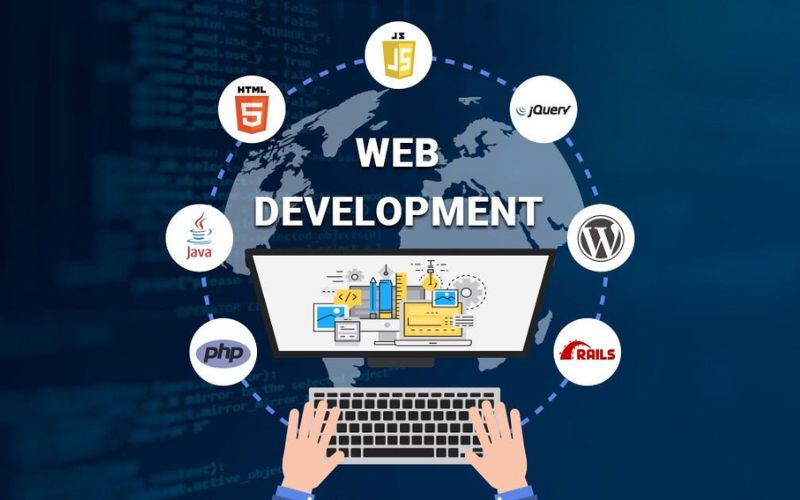Mastering
Frontend Development: Tools and Technologies You Need to Know
Since
frontend development is concerned with UI creation and smooth UX, it is an
essential component of web development.
Developers
require a toolset of vital tools to debug code, optimize workflow, and produce
beautiful websites and online applications in order to succeed in this area.

In order for
developers to remain competitive in the always-changing field of web
development, I will go over ten must-have front-end development tools in this
blog article.
Frontend web development
tools
Below we
have mentioned some of the most important frontend technologies and tools you
need to know.
Text Editors and Integrated
Development Environments
The
essential tool for any front-end developer is a solid text editor or integrated
development environment.
Code
highlighting, autocomplete, and a plethora of extensions are just a few of the
features that popular programs like Visual Studio Code, Sublime Text, and Atom
provide to boost productivity.
🔘 Related: Top Front End Programming Languages 🔘
Version Control Frameworks
Code
management and collaboration depend on version control. Developers may quickly
roll back to earlier versions of their work, interact with others, and log
changes when using Git in conjunction with GitHub or GitLab.
The industry
makes extensive use of Git, a distributed version control system. This is the
reason why:
Git enables
developers to work on many branches, which facilitates the management of
feature development and the reintegration of changes into the main source.
👉 Collaboration:
Git enables several developers to work on a project at once and makes it simple
to monitor the changes made by each team member.
👉 Revert and
rollback: Git offers the capability to reverse commits, roll back changes, and
return the codebase to a prior stable state.
👉 Git and other
version control systems facilitate easy developer collaboration while
guaranteeing the integrity of the codebase during the development process.
Frontend Libraries and
Frameworks
An overview
of well-known frontend frameworks and libraries, such as React, Angular, and
Vue.js, is given here.
We go over
their advantages, applications, and ecosystem, which include routing, state
management, and component-based design.
Managers of Packages
Yarn and npm
(Node Package Manager) are two examples of package managers that make it easier
to install and manage dependencies and libraries in your front-end
applications. They make it simple to maintain an ordered and current codebase.
Installing,
updating, and maintaining third-party libraries and dependencies is made easier
by using package managers. The following are two popular package managers:
· The Node.js
default package manager, npm (Node Package Manager) is widely used in the
JavaScript community. It makes it simple for developers to organize and install
libraries for their projects.
· Yarn: Another
well-liked package management for front-end applications, created by Facebook.
In comparison to npm, it provides faster and more dependable dependency
resolution.
CSS/HTML Preprocessors
Variables,
mixins, and other features are added to CSS by tools like Sass and Less. They
cut down on duplication in your code and improve the efficiency and
maintainability of style.
JavaScript libraries and
frameworks
The
foundation of front-end development is JavaScript. Frameworks like Angular,
Vue, and React.JQuery and other frameworks offer strong capabilities for
creating responsive and interactive online apps.
Tools for Testing
Responsive Designs
It's crucial
to make sure your websites appear fantastic across a range of screen sizes.
You may
efficiently test and debug responsive designs with the use of tools like
BrowserStack, the Chrome DevTools Device Mode, and browsers' Responsive Design
Mode.

Tools for Performance
Optimization
For users to
be satisfied, frontend performance is essential. You may assess and enhance the
functionality of your website to make it quicker and more effective with the
assistance of tools like Lighthouse and Google PageSpeed Insights.
Tools for Debugging Code
A typical
step in the development process is debugging. Debugging capabilities in Visual
Studio Code and Chrome DevTools are two examples of strong tools that can be
used to find and solve errors in your code.
Builder Tools and Task
Runners
Automating
repetitious processes like concatenation, image optimization, and minification
is done via task runners like Gulp and Grunt.
Build
technologies such as Webpack facilitate the effective bundling and asset
management of your project.
Code is
optimized for production and repetitive processes are automated with task
runners and build tools. In this field, two well-liked instruments are:
· Grunt: Grunt is
a JavaScript task runner that makes it possible to automate processes like
testing, compilation, and minification.
· Gulp: Gulp is a
build tool that automates operations using a streaming methodology. It provides
a large selection of plugins for image, JavaScript, and CSS optimization.
Task runners
and build tools increase the productivity of developers by automating tedious
activities and performance-enhancing code.
Extensions for Browsers
Front-end
developers benefit from browser extensions such as WAVE, ColorZilla, and Vue.js
Devtools, which offer in-browser accessibility audits, color selection, and
debugging features, respectively.
Web browser development
tools
We examine
the integrated developer tools offered by web browsers, such as Firefox development
Tools and Chrome DevTools.
We go
through all of their features, such as network analysis, performance profiling,
debugging JavaScript, and DOM inspection and manipulation.
Developer
tools (DevTools) are built into browsers and offer a wealth of functions for
troubleshooting, evaluating, and optimizing online applications. Notable
DevTools for browsers include:
· Google Chrome
DevTools: Chrome's DevTools provide an extensive collection of tools for
network monitoring, JavaScript profiling, CSS debugging, and other uses.
· Firefox
Developer Tools: With a robust CSS editor and JavaScript debugger, Firefox's
Developer Tools offer functionality that is comparable to those of Chrome
DevTools.
· Safari Web
Inspector: For developers working on Apple platforms, Safari's Web Inspector
provides several debugging and analysis capabilities.
With the
help of Browser DevTools, developers may examine and improve their code, making
the user experience more polished and effective.
Essential Frontend
Development Skills
We'll
discuss the essential abilities that each front-end developer needs to have in
this section.
The
foundations of HTML and CSS, the capabilities of JavaScript, the significance
of responsive design, and the use of CSS frameworks and preprocessors will all
be covered.
We'll also
discuss how important version control is to effective teamwork while using Git.
· HTML and CSS
Fundamentals: We go over the fundamental ideas of HTML and CSS, such as how
HTML documents are structured, how to style web pages with CSS selectors and
attributes, and how to use semantic HTML components to organize information.
· Mastering
JavaScript: We go into the capabilities of this language and how it can be used
to build dynamic, interactive websites. Working with variables, functions,
conditionals, loops, manipulating the DOM, and managing events are among the
topics covered.
· We talk about
the significance of responsive design in building websites that adjust to
various screen sizes and devices in our discussion on mobile optimization. We
look at methods like as responsive design, media queries, and mobile-friendly
image optimization.
· CSS
Preprocessors and Frameworks: Sass and Less are two examples of CSS
preprocessors that improve CSS by adding variables, mixins, and functions,
which make stylesheets easier to maintain and more effective. We also talk
about prominent CSS frameworks that offer pre-built components and responsive
grid systems, such as Tailwind CSS and Bootstrap CSS.
· Version Control
with Git: We emphasize the importance of version control in frontend
development that is collaborative. The fundamentals of Git are covered,
including branch creation, commit changes, dealing with remote repositories,
and initializing repositories.
Best Practices for Frontend
Development
The best
practices for improving the quality and maintainability of front-end
programming will be the major topic of this section.

In this
session, we'll go over how to write clear, well-organized code, optimize speed
for quicker website loads, make sure that websites work across browsers, add
accessibility features, and use efficient testing and debugging methods.
We'll also
talk about effective workflow techniques and cooperation methods.
📝 Writing Clean
and Maintainable Code: We go over the significance of clean code guidelines,
such as modularization, naming standards, correct code layout, and
documentation. We also discuss the advantages of code reviews and code linting.
📝 Performance
Optimization strategies: This section covers frontend performance optimization
strategies including caching, minimizing HTTP requests, minifying and
compressing content, and loading resources slowly. We also talk about how
performance affects search engine optimization (SEO) and user experience.
📝 Cross-Browser
Compatibility: We explore the difficulties in maintaining uniform website
rendering between various web browsers and offer methods for troubleshooting
and resolving browser-specific problems. We also talk about the significance of
gentle decline and gradual augmentation.
📝 Inclusive design
and accessibility: We stress the need to develop web experiences that are
accessible to people with impairments. Using semantic HTML, offering alt text
for pictures, keyboard accessibility, and adhering to Web Content Accessibility
Guidelines (WCAG) are some of the topics covered.
📝 Testing and
Debugging: We examine front-end code testing approaches such as end-to-end,
integration, and unit testing. We also go over debugging methods with tools
such as code formatters and liters, as well as browser developer tools.
📝 Cooperation and
Workflow Efficiency: Using version control systems, using agile approaches,
employing project management tools, and creating efficient communication
channels are some of the techniques we cover for fostering productive
cooperation in front-end development.
Enhancing Efficiency with
State-of-the-Art JavaScript Frameworks for Front-End Programming
JavaScript
frameworks for front-end programming are:
React
Facebook
maintains the well-known JavaScript library React. Building user interfaces
using it is common, particularly for one-page apps.
Performance
is enhanced with quick updates and effective rendering made possible by React's
virtual DOM. Among React's principal benefits and features are:
· Component-based
architecture: React enables the creation of reusable user interface components,
which accelerates and improves the efficiency of development.
· Virtual DOM:
React's virtual DOM minimizes the need for direct DOM operations, which speeds
up rendering and enables effective updates.
· React Native:
React allows developers to save time and effort when creating mobile apps by
leveraging the same codebase as their online applications.
Angular
A
feature-rich framework called Angular is created and maintained by Google. It
offers a complete approach to developing dynamic websites.

Angular is a
fantastic option for development that prioritizes performance because of its
robust capabilities and optimizations. Angular's salient attributes and
benefits encompass:
· Two-way data
binding: Angular's two-way data binding makes it easier to synchronize data
between the model and the view, which makes the application more effective and
responsive.
· TypeScript: A
statically typed superset of JavaScript, TypeScript is used in the construction
of Angular. Strong typing is one of the significant features added by
TypeScript that helps identify problems early and enhances the quality of the
code.
· Dependency
injection: Code reuse, simple testing, and modular development are made
possible by Angular's dependency injection mechanism.
Vue.js
A
progressive JavaScript framework with an emphasis on simplicity and speed is
called Vue.js.
It provides
a balance between being simple to use and having the capacity to create
intricate applications.
Vue.js is a
great option for front-end development since it offers fast rendering and
effective updates. Principal benefits and attributes of Vue.js comprise:
📜 Virtual DOM:
Vue.js renders and updates the user interface (UI) quickly and smoothly by
making use of a virtual DOM. Reusable components may be made by developers
using Vue.js, which improves code maintainability and speeds up development.
📜 Flexible
ecosystem: Vue.js is appropriate for both small and large-scale applications as
it can be progressively integrated into current projects.
📜 Size and
performance: Vue.js performs better and loads pages more quickly because of its
lightweight design.
Modern
JavaScript frameworks like as React, Angular, and Vue.js allow developers to
greatly increase front-end development performance. The main conclusions are as
follows:
📜 React is an
excellent option for creating effective user interfaces as it provides a
virtual DOM and a component-based design.
📜 Angular offers
TypeScript integration, two-way data binding, and optimized rendering for
high-performance, responsive apps.
📜 With a virtual
DOM for quick rendering and updates, Vue.js provides a lightweight solution
with an emphasis on simplicity and flexibility.
📜 By carefully
choosing and utilizing these JavaScript frameworks, developers may build
user-friendly, fast, and interactive online apps.
Conclusion
You should
weigh each tool's benefits and drawbacks before deciding which one best meets
your needs and objectives.
However, we
strongly advise business owners who want to expand their enterprise faster to
get in contact with our team of experts.
With our
knowledgeable staff of iOS, Android, and desktop app developers, we might be
able to meet your needs.
It may be
helpful to you, therefore I sincerely invite you to browse our website and see
if there is anything we can do to assist.